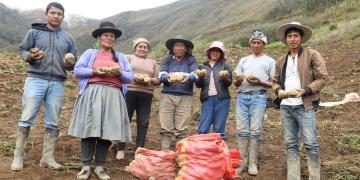Bélgica: Pandemic impact: Home consumption of fresh potatoes in Belgium increased by eight percent
Potatoes are the top side dish in Belgium. On an average day in 2020, 41% of Belgians ate these (incl. fries). A lot of people were already eating potatoes at home. But, due to COVID-19 and its related measures, that rose in 2020.

That’s according to a Flemish Agri and Fisheries Marketing Center (VLAM) press release.
In 2020, home consumption of fresh potatoes increased by eight percent. That ended the downward trend in in-home consumption.
The shift from large to small packaging also came to a halt in 2020. And people were buying relatively more from green grocers and directly from farmers. The volume share of Belgian potatoes increased slightly to 76%. Organic potatoes’ status quo remained at five percent volume share.
This is all evident from VLAM’s Consumption tracker, and an online survey done by iVox, a Belgian market research and polling agency. As well as data VLAM purchased from another research firm, GfK Belgium. This company followed 6,000 Belgain households’ purchases for home consumption.
Potatoes – top Belgian side dish
The VLAM Consumption tracker asked Belgians what they’d eaten the day before. That was done every day in 2020. It seems potatoes are the most eaten side dish in Belgium. On an average day, 41% of Belgians ate potatoes (incl. French fries). Twenty-three percent ate pasta, 9% rice, 3% noodles, and one percent ate quinoa. Proportionally, more 55 to 64-year-olds, Flemish people, cohabitants, and families with children ate potatoes. As did lower educated people, people living in rural areas and those with Belgian roots. Boiled potatoes remain the most common preparation, followed by fries, mashed, and jacket potatoes.
Most potatoes consumed at home
In 2017, Belgians ate cooked potatoes at home 85% of the time. That was true for non-fried potatoes too. The situation is different for French fries. In 2017, people in Belgium consumed these at home only 53% of the time. They ate relatively more of them in restaurants and other places (e.g. events, festivals). Pasta and rice were also mainly eaten at home. But compared to cooked potatoes, pasta and rice were eaten more often in restaurants and at work/school.
Non-fried potatoes, therefore, have a significant home use profile. COVID-19 and its measures (hospitality closure, cancelled events, mandatory working from home) saw an increase in this in-home consumption. In 2020, in no fewer than nine out of ten times (89%), Belgians ate boiled potatoes at home. For a more typical out-of-home product like fries, the shift was even more dramatic.
The share of home consumption increased from 53% in 2017 to 70% in 2020. That was at the expense of consumption outside the home (mainly eateries and other channels). However, home fries consumption didn’t fully compensate for the partial loss of out-of-home consumption. On an average day in 2017, 12.3% of Belgians ate French fries. That fell to 10.6% by 2020.
Home use of fresh potatoes up by 8%
In 2020, there was a shift from out-of-the-home to home use of products. That was due to the COVID-19 rules. That was reflected in the in-home consumption figures of fresh potatoes too. Home consumption dropped from 23.3 kg per capita in 2016 to 20.5 kg in 2019. That rose again in 2020 to 22.0 kg per capita (+8%). This considerable increase is seen among singles, higher social groups and in Brussels. Incidentally, these aren’t the population groups that usually eat out relatively more.
There was a significant volume increase in especially the first lockdown (+17% versus the same time in 2019). Between the two lockdowns, this fell to +3%, only to rise again during the second lockdown. But then it rose less sharply than during the first lockdown (+12%). Daily penetration figures also show that during the first lockdown, Belgians relatively more often ate boiled potatoes. During that period, more Belgians returned to tried-and-tested, traditional dishes.
Fresh potatoes have an annual penetration of 90%. So, they remain a product that just about every household in Belgium buys. They do so 14 times a year, on average. In previous years, the number of purchasing households remained stable. And the purchase frequency also only decreased slightly. That decrease was mainly in the volume per purchase. Smaller packs (<5 kg) became increasingly popular. In 2020, however, due to the pandemic, the volume per purchase increased again.
Larger packs gained more importance too. People had to cook at home more, so they needed more potatoes. Also, to keep the risk of infection sufficiently low, people visited stores less often. They, therefore, bought more per shopping trip. More people also began shopping at places like green grocers and via short chains (see below). There, they bought comparatively larger quantities of potatoes.
Three-quarters of potatoes bought were locally-grown, 5% organic
Three-quarters of bought potatoes were locally-grown (a slight increase compared to 2019). The share of Belgian potatoes is, naturally, highest for direct purchases. That share (above 80%) is, however, high at larger supermarkets and at neighborhood stores too. The share of local potatoes is lowest (67%) at discounters. In 2020, Belgian potatoes’ share was highest in Q1 and Q4.
Organic potatoes’ volume share grew in previous years. It rose from 3,4% in 2016 to 5% in 2019. In 2020, that remained at 4,9%.
Greengrocers, short chains market share up in the 2020 COVID-19 year
Hypermarkets and supermarkets (DIS 1) are still the most important purchasing channel for fresh potatoes. They have a volume share of 39%. Discounters like Aldi and Lidl follow with 30%. Then it’s neighborhood stores with 14%. In recent years, these last two groups have been the potato market’s rising stars. However, in 2020, Belgians started buying proportionally more from greengrocers and directly from growers. That ended the declining market share of these two channels.
For more information:
Liliane Driesen
VLAM
Tel: +32 (0) 479 989 945
Emal: liliane.driesen@vlam.be
Website: www.vlaanderen.be/vlam/
Fuente: https://www.potatonewstoday.com/2021/06/25/pandemic-impact-home-consumption-of-fresh-potatoes-in-belgium-increased-by-eight-percent/




